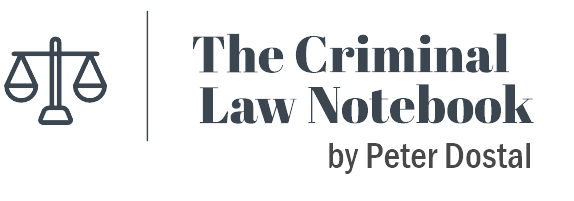Sentencing Brief (Generic): Difference between revisions
No edit summary |
No edit summary |
||
| Line 34: | Line 34: | ||
* [list optional terms, including duration of ancillary orders] | * [list optional terms, including duration of ancillary orders] | ||
[X] The remainder of these written submissions will be organized into the following Parts: | |||
:[list the Parts] | |||
<Center><u>'''PART II: AGREED FACTS AND OTHER EVIDENCE'''</u></center> | <Center><u>'''PART II: AGREED FACTS AND OTHER EVIDENCE'''</u></center> | ||
Revision as of 16:13, 14 March 2019
Briefs
A sentencing brief is structured as follows:
- Overview
- Identify the charges, including time, place and section of the code.
- Identify the issue for sentencing
- Outline desired result
- Facts
- Summary of undisputed Facts
- Summary of anticipated disputed facts, including what witnesses will be provided
- Enumeration of relevant exhibits
- Positions of Parties
- Principles of Sentencing
- Objectives to be emphasized in Case
- Applicable Factors
- Prior Cases
- Analysis / Discussion of Case
- Ancillary Orders
- Legal Requirements of Order
- Interpretation of Provisions
- Discussion of Application
- Summary of Party's Position
- Breakdown of the requested Sentence, including any factual
| Cover of Brief | ||||||||||||||||||||||||||||||||||||||||||||||||||||||||||||||||||||||||||||||||
|---|---|---|---|---|---|---|---|---|---|---|---|---|---|---|---|---|---|---|---|---|---|---|---|---|---|---|---|---|---|---|---|---|---|---|---|---|---|---|---|---|---|---|---|---|---|---|---|---|---|---|---|---|---|---|---|---|---|---|---|---|---|---|---|---|---|---|---|---|---|---|---|---|---|---|---|---|---|---|---|---|
|
C A N A D A File# ________________ IN THE [LEVEL OF COURT] OF [PROVINCE] BETWEEN: – and –
CROWN/ACCUSED SENTENCING BRIEF | ||||||||||||||||||||||||||||||||||||||||||||||||||||||||||||||||||||||||||||||||
| Table of Contents | ||||||||||||||||||||||||||||||||||||||||||||||||||||||||||||||||||||||||||||||||
|
TABLE OF CONTENTS(e)
| ||||||||||||||||||||||||||||||||||||||||||||||||||||||||||||||||||||||||||||||||
| Body of Brief | ||||||||||||||||||||||||||||||||||||||||||||||||||||||||||||||||||||||||||||||||
|
[X] On [date], the accused [plead/was found] guilty to the commission of the following offence(s) between [date]. Specifically that he:
The Crown elected to proceed by indictment/summary conviction on the hybrid offences. [X] It is the Crown/Defence position that a fit and proper sentence for the offences charged are as follows:
[X] The terms of the conditional sentence order should be as follows:
[X] The terms of the probation order should be as follows:
[X] The terms of the ancillary orders should be as follows:
[X] The remainder of these written submissions will be organized into the following Parts:
[X] The parties are not in agreement on what the fit and proper sentence would be for this accused, including the appropriate form of disposition, duration of custody, the terms of probation, and ancillary orders. [X] The A. Purpose and Principles of Sentencing B. Proportionality C. Parity D. Restraint E. Totality and Concurrent vs Consecutive Sentences [assuming multiple offences charged] A. Purpose of Criminalization of Conduct B. Objectives to be Emphasized B. Range of Sentence [X] Generally across Canada, the sentencing range for the offence of ... ranges anywhere between .... [X] The recommended sentence presented here is in light of cases from within the province: [list of cases and short summaries] [X] There are also cases from elsewhere in Canada including the following: [X] The recommended sentence presented here is in light of cases from within the province:
A. Gravity of Conduct [consider the relationship of trust, the degree of physical or psychological harm] A. Sophistication of the Offence B. Vulnerability of Victim C. B. Guilty Plea and Acceptance of Responsibility B. Prior Criminal Record and Repeat Offenders B. Prospects of Rehabilitation
[X] A joint recommendation that is presented to the Court can only be adopted where the court is satisifed, after hearing all the evidence and submissions, that the proposed sentence would not bring the administration of justice into disrepute or otherwise be contrary to the public interest. This "public interest test" was most recently outlined in R v Anthony-Cook, 2016 SCC 43. Justice Moldaver, writing for the Court, outlined the test as follows:
[X] Justice Moldaver described the importance of having a high threshold to reject a joint recomendation:
[X] Under the Anthony-Cook approach to joint recommendation, an added obligation is placed on both counsel to provide sufficient information about the offence, offender, and circumstances of the proceedings that brought about the agreement:
[X] Should the Court be inclined to reject the joint recommendation, the sentencing judge cannot simply declare the agreement inappropriate and proceed to determine a fit and proper sentence. The Court must provide notice to counsel that there are concerns and invite counsel to make further submissions, invite a potential withdraw of guilty plea, and only after that must give "clear and cogent" reasons for the rejection.
[ A. Restitution Orders B. Forfeiture Orders C. DNA Orders D. SOIRA Orders Based on the foregoing and as supplemented by oral submissions, the [Crown / defence] beleieve a fit and proper sentence is as follows:
[X] We are also recommending the following ancillary orders: [list the orders requested and their duration] ALL OF WHICH IS RESPECTFULLY SUBMITTED DATED at ______________, in the Province of _______________, this _____ day of _____________, 20___.
| ||||||||||||||||||||||||||||||||||||||||||||||||||||||||||||||||||||||||||||||||
| Table of Authorities | ||||||||||||||||||||||||||||||||||||||||||||||||||||||||||||||||||||||||||||||||
|
PART X: TABLE OF AUTHORITIES(e)
| ||||||||||||||||||||||||||||||||||||||||||||||||||||||||||||||||||||||||||||||||
